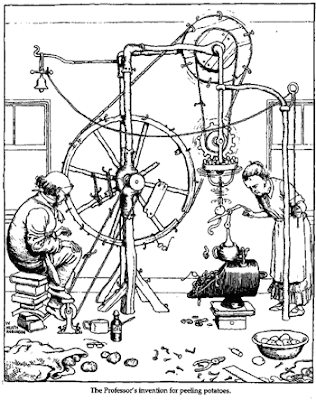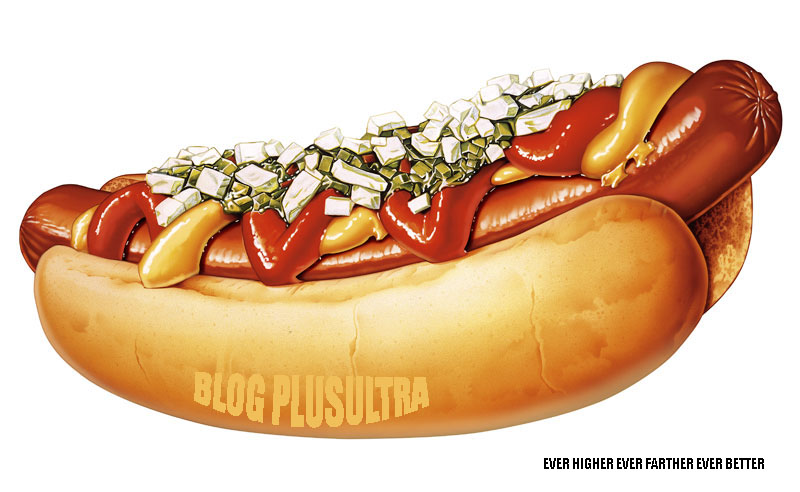
Some of our readers out there have been wondering what happened to Plus Ultra? Has he given up the struggle to get higher, farther and better?
Of course not! Plus Ultra is merely streamlining his operation with the help of a Rube Goldberg machine! Soon the posts you read on Blog Plus Ultra will be automated thanks to this incredible time saving invention! Unfortunately we are experiencing a few snags along the way, so here are a few videos to demonstrate the type of simple straightforward improvements Plus Ultra is making.
Rube Goldberg Machine
From Wikipedia

A Rube Goldberg machine is an exceedingly complex apparatus that performs a very simple task in a very indirect and convoluted way. It first appeared in Webster's Third New International Dictionary with the definition, "accomplishing by extremely complex roundabout means what actually or seemingly could be done simply." The expression has been dated as originating in the US around 1930 to describe Rube Goldberg's illustrations of "absurdly-connected machines".
Since then, the expression's meaning has expanded to denote any form of overly confusing or complicated system. For example, recent news headlines include "Is Rep. Bill Thomas the Rube Goldberg of Legislative Reform?", and "Retirement 'insurance' as a Rube Goldberg machine". It has been argued that fissioning uranium to boil water under tremendous temperature and pressure renders nuclear power a Rube Goldberg machine.

Similar expressions internationally
The expression "Heath Robinson contraption", named after the fantastical comic machinery illustrated by British cartoonist W. Heath Robinson, shares a similar meaning but predates the Rube Goldberg machine, originating in the UK in 1912.
In Denmark, they are called Storm P maskiner (Storm P machines), after the Danish cartoonist Robert Storm Petersen.
In Bengal, the humorist and children's author Sukumar Ray in his nonsense poem Abol tabol had a character ('Uncle') with a Rube Goldberg like machine called 'Uncle's contraption'. This word is used colloquially in Bengali to mean a complex and useless machine.
In Spain, devices akin to Goldberg's machines are known as Inventos del TBO (tebeo) named after those which cartoonist Ramón Sabatés made up and drew for a section in the TBO magazine, allegedly designed by some Professor Franz from Copenhagen.
The Norwegian cartoonist and storyteller Kjell Aukrust created a cartoon character named Reodor Felgen who constantly invented complex machinery. Though it was often built out of unlikely parts, it always performed very well. Felgen stars as the inventor of an extremely powerful but overly complex car Il Tempo Gigante in the Ivo Caprino animated puppet-film Flåklypa Grand Prix (1975).
In Turkey, such devices are known as Zihni Sinir Proceleri, allegedly invented by a certain Prof. Zihni Sinir (Crabby Mind), a curious "scientist" character created by İrfan Sayar in 1977 for the cartoon magazine Gırgır. The cartoonist later went on to open a studio selling actual working implementations of his designs.
Another related phenomenon is the Japanese art of useful but unusable contraptions called chindōgu.
In the famous Tamil movie Aboorva Sagotharargal Kamal Hasan (Being a Circus clown) uses a 'Rube Goldberg Machine' made out of circus components to kill a villan.
In Austria, Franz Gsellmann had built for decades on a machine that he named the "Weltmaschine" (world-machine) it has many similarities to a Rube Goldberg machine.Some have compared machines of this nature in a very general way to the old adage of reinventing the wheel.

Machine contest
Many Designers of Rube Goldberg machines participate in competitions, such as this one in New Mexico.In early 1987, Purdue University in Indiana started the annual National Rube Goldberg Machine Contest, organized by the Phi Chapter of Theta Tau, the National Professional Engineering Fraternity. The contest is sponsored by the Theta Tau Educational Foundation. It features US college and university teams building machines inspired by Rube Goldberg's cartoon. Judging is based on the ability of the machine to complete the tasks specified by the challenge using as many steps as possible without a single failure, while making the machines themselves fitting into certain themes.
